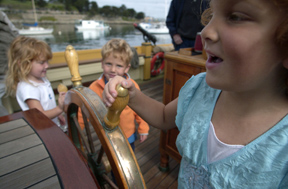
Replica of the 1812 Privateer Lynx travels along the California
coast
Deep inside the heart of many a sea-loving soul burns a secret
desire
– the yearning to be a pirate.
Replica of the 1812 Privateer Lynx travels along the California coast
Deep inside the heart of many a sea-loving soul burns a secret desire – the yearning to be a pirate.
Aye, matey – pirate dreams are shared by men, women and children throughout the world. And this weekend, local pirates have the rare opportunity to get a glimpse of what a life sailing the Seven Seas on an old-time ship may have been like.
The 1812 Privateer Lynx, an interpretation of an actual privateer ship named Lynx from the War of 1812, recently closed out a three week stop in Monterey and will dock today at 3 p.m. at Pillar Point Harbor in Half Moon Bay. Free dockside tours will be available from 4-5 p.m. This weekend, dockside tours will be held from 9 a.m. to noon at a cost of $5 per adult and free for children under 12. Three hour adventure sails are available both days – cost is $55 for adults and $30 for children.
The actual Lynx was one of the first ships to defend America’s coastline. When the War of 1812 started, the U. S. Navy had just 17 ships in its fleet. Owners of private vessels were granted special permission to attack enemy ships, making them “privateers,” since the Navy did not have enough ships to defend both coasts. Although these ships rarely engaged warships, they created a blockade and their presence created a sense of fear among English trade vessels, who insisted on escorts, drawing warships away from engagement with the few real Navy ships.
One of the privateers near Maryland was a top-sail schooner, named Lynx. Because privateers were so efficient at their job, the ship yards that built the ships became primary targets for the British. A particularly intense battle was fought near Fell’s Point in Baltimore, MD., where the Lynx was built. Beginning Sept. 13, 1814, the British Navy bombarded Fort McHenry, which protected Baltimore’s inner harbor, with more than 1,500 iron shot and mortar shells, but were unable to gain entrance to the harbor. This battle was witnessed by Francis Scott Key, who wrote the song “Star Spangled Banner.”
Unfortunately for the original Lynx, it was captured early in the war, but its style and appearance were the inspiration for today’s Lynx. Its design has been modified to meet current U.S. Coast Guard regulations and safety requirements, and it has many modern tools and specifications. However, its crew works hard to maintain the ship’s early American heritage. The crew wears period costumes, flies period flags and pennants from the ship’s masts and fires the main battery of six-pound carronades.
Aside from public tours and sailing adventures, the Lynx is also available for educational field trips through the Lynx Educational Foundation, allowing students to learn about seafaring traditions and early American maritime history. The Lynx has also been used in numerous movie and commercial shoots, and was used to train the cast and crew of Disney’s “Pirates of the Caribbean” movies.
The Privateer Lynx will be in Oakland April 18-25 and will then sail along the California coastline. It will travel to Hawaii and Oregon before arriving at Moss Landing in October.
For more information about the 1812 Privateer Lynx, go to www.privateerlynx.org.
Some of the information used in this story was provided by the 1812 Privateer Lynx Web site.









